The connected home robot that could make you more healthy
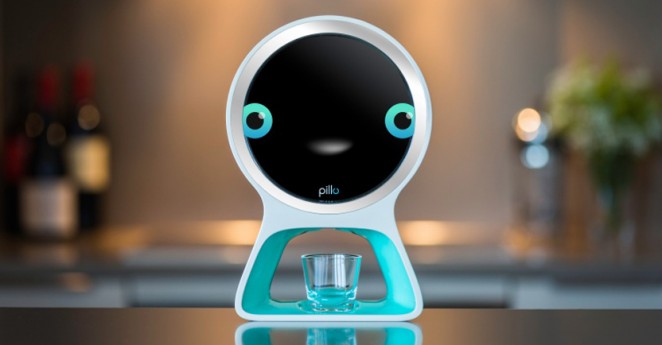
 A home robot has been invented that can help consumers take care of their health needs by providing them with medical advice and dispensing medicine. Pillo can hold up to four weeks’ worth of medication, which it will distribute to the user’s needs. It can also sense when you are running low on and order new medication as and when it's required. If you have a health related question Pillo, can also connect you with a healthcare professional using its HD screen. It will also give you gentle reminders to make sure you stay on track with your medication and health goals. The robot uses facial and voice recognition in conjunction with an ability to learn. This means that Pillo will not only respond to commands but will also gradually be able to proactively care for a whole family each with different evolving needs as they age. If this means he'll learn to dispense paracetamol every Sunday morning for the standard post-session hangover once the kids hit their teens, I'll be genuinely impressed.
A home robot has been invented that can help consumers take care of their health needs by providing them with medical advice and dispensing medicine. Pillo can hold up to four weeks’ worth of medication, which it will distribute to the user’s needs. It can also sense when you are running low on and order new medication as and when it's required. If you have a health related question Pillo, can also connect you with a healthcare professional using its HD screen. It will also give you gentle reminders to make sure you stay on track with your medication and health goals. The robot uses facial and voice recognition in conjunction with an ability to learn. This means that Pillo will not only respond to commands but will also gradually be able to proactively care for a whole family each with different evolving needs as they age. If this means he'll learn to dispense paracetamol every Sunday morning for the standard post-session hangover once the kids hit their teens, I'll be genuinely impressed.
The machine’s hard outer-casing makes it tamper-proof, and it also has a finger-print scanner for extra security. Its added extras include an ARM processor, touchscreen, HD camera, multiple microphones, speaker, wi-fi connectivity and bluetooth, and in the event of a power cut, a lithium-ion battery will kick in making sure Pillo continues to work. Pillo is a platform built on the open-source Android OS, so developers will also have the opportunity to continue to imagine new ways to integrate the robot into people’s daily healthcare routine. The robot can sync with other devices such as blood-pressure monitors, smart watches and digital scales. This will enable the user to get a holistic picture of their health and adjust their healthcare appropriately. It also comes with a mobile app allowing allows consumers to receive personal notifications straight to their phones.
The App Tackling HIV Stigma
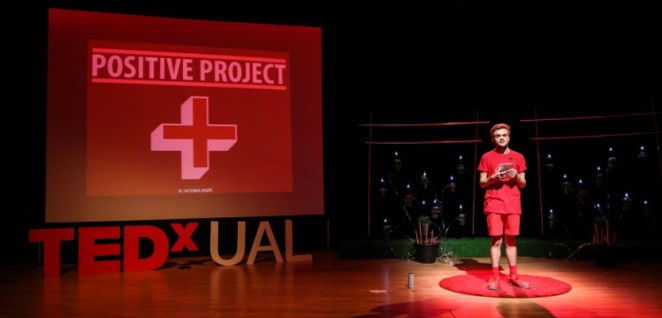

Jacob Alexander was diagnosed with HIV on the day of his 22nd birthday last year, and in the months following his diagnosis, the London College of Fashion student was shocked by the number of ill-informed, insensitive questions he was asked about the virus. Some people apparently didn't even realise that it still existed! Even his own best friend’s response was to stigmatise him. Instead of getting angry, Alexander decided to instead built something positive from the hand he'd been dealt, and designed The Positive Project app, alongside his debut menswear collection JacobAlexndr, to tackle this ignorance and improve education about HIV. Young HIV sufferers are offered support through the app, which provides information about the virus’ history and health advice about the causes and symptoms, as well as listing treatment centres. Users can then contact the centres directly through the app, ask questions anonymously and book appointments. A bright red 3-D cross with a neon border features as the focal point across the app, while three shades of red are used throughout the rest of the design to represent Alexander’s own blood type: O+.
Another key design feature is an interactive map where supporters can upload selfies of themselves wearing the bright red The Positive Project t-shirt, also designed by Alexander and available to buy through the app. A percentage from every t-shirt sold goes to the St Stephen’s Aids Trust and sexual health clinics, 56 Dean Street and Dean Street Express. The app is also in the process of being integrated into the Positive Project website, which Alexander hopes will launch soon. Most importantly, he also recognises the importance of design in bringing about social change, particularly around controversial subjects like HIV. He said: “Design can be used as a powerful tool to change people’s opinions. You can design something on a t-shirt, send that t-shirt out into the world, and that’s a message that people can wear and see.” The Positive Project app is free to download now from the App Store.
Man claims he invented the iPhone in 1992

Apple are no strangers to controversy, but this one pretty much takes the biscuit. A man named Thomas Ross claimed recently that he invented the iPhone way back in 1992, and has now sued Apple for $10 billion accordingly. According to The Guardian, Ross says the iPhone, iPad, and iPod all infringe his invention of an “Electronic Reading Device.” Ross says he worked on the design for over a year before filing a patent in November 1992. He never followed through with the design because of a lack of funds, and failed to pay the required fees to protect the ERD, and the US Patent and Trademark Office declared his application abandoned in 1995. Last year, Ross' lawyer sent a cease and desist letter to Apple CEO Tim Cook, however he received a reply from Apple's Jeffrey Lasker, who said there was no merit to the claims. However, Ross has now filed a lawsuit for $10 billion, and wants Apple to forfeit the patents supposedly derived from his original designs (which you can see above). Big words, and it'll probably go nowhere, but it's certainly another interesting David and Goliath story. In the real world though. David never wins.
Microsoft's hand tracking tech
In yet another move that might eventually make the humble pen and paper obsolete, Microsoft researchers are reportedly in the process of engineering a gestural user interface technology that may enable designers to create every day designs through simple hand motions. The new demo of the platform, called “Handpose,” recognises detailed hand movements and allows users to manipulate technology through simple and complex gestures. The tracking system is apparently far more accurate than its predecessors and requires minimal processing power, giving it potential for use in computers, tablets and VR headsets. The computer scientists and engineers behind the project claim they are close to advancing hand and gesture recognition tools enough for mainstream use. Its widespread usability would signal a turning point for interactive and responsive design. Still in its research phase, the system tracks subtle hand motions and allow the user to perform tasks like poke a stuffed bunny, press buttons or move a slider while observing their movements through a virtual reality headset or screen monitor. Handpose allows users to see what their hands are doing and addresses a common disconnect that occurs when VR users can’t see their own hands, which often results in nausea.
For years researchers have faced difficulties in tracking hands because they are so small and complex compared to arms, legs and torsos. Gestures like forming a fist would cause the subject’s fingers to disappear from view and confuse the software in earlier builds. The new system, however, creates a smooth surface model of the hand tracked by data points, and uses an algorithm that was developed in the 1940s to calculate where the tracking points should go next, creating a fluid image and gesture. The team of researchers behind Handpose were surprised to find that a lack of haptic feedback didn’t vastly affect the usability of the system. That is due, in part, to the company’s design of the virtual world. The researchers created virtual controls that are thin enough for users to touch their fingers together to imitate the sensation of touching something physical. They also developed sensory experiences that varied in resistance and authenticity. Of course, this is all just research right now, but it's certainly food for thought for technologically savvy designers.
The violin made from spider silk
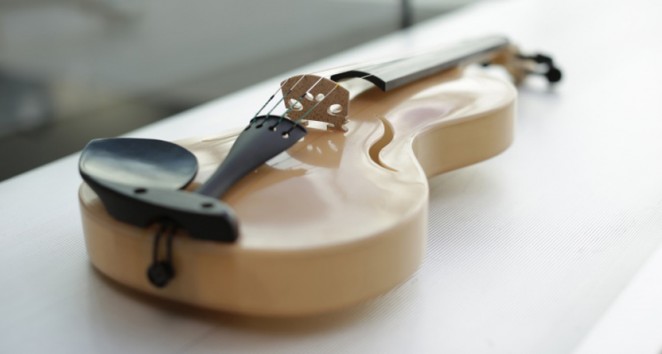
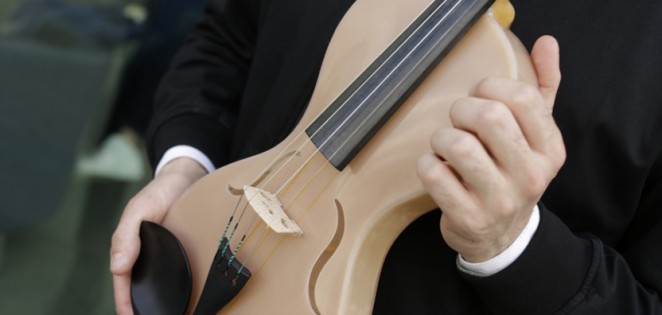
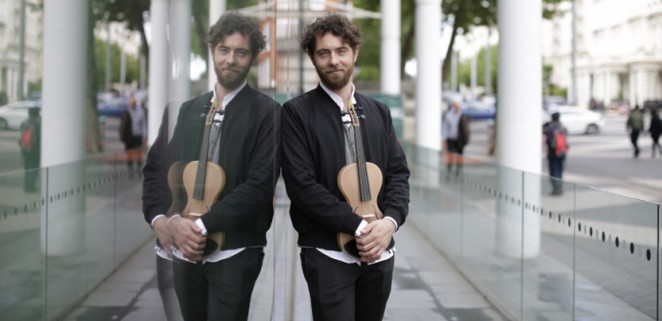
A postgraduate student at the Dyson School of Design Engineering, Imperial College London has developed a prototype violin made from materials including spiders’ silk. Luca Alessandrini has developed a composite material made from worm silk and a binding agent instead of wood, impregnating the violin’s top side with three strands of golden silk spun by an Australian golden orb spider. Alessandrini says he wanted to work with spiders’ silk in particular due to its two defining characteristics: strength and elasticity. When the prototype violin is played the spiders’ silk vibrates the instrument’s composite casing, which then emits a musical sound. Placing the 35cm long strands of spiders’ silk directly under the bridge of the violin was the most effective way to make use of such a small amount of the material, which is both incredibly rare and expensive.
Alessandrini (great name by the way) has also been experimenting with how the prototype’s different fibres are mixed together, in order to show that its acoustics can be customised depending on the sound that is required. This principle could then be applied to other products such as speakers, amplifiers and headphones. The technology used in the violin prototype has just been patented. Alessandrini is now looking for partners to set up a start-up business and develop the technology further, and hopes it will make it to the marketplace by 2017.
Nintendo confirms it's officially in the VR game

At its first shareholder's meeting for the fiscal year, Nintendo has officially and finally (some might argue) confirmed it's actively researching virtual reality. Whether or not this relates to its upcoming, and still highly secretive NX console, however, remains to be seen. Per reports from Twitter, gaming legend Shigeru Miyamoto said the company was actively researching VR. He said: “Long play sessions are an issue. We want to release something that can be played for long periods, carries value, and is affordable. We want parents to feel at ease.” VR functionality is but one of many rumours around Nintendo's new console, which has a release window of March, 2017. We currently know very little about the machine, and it was absent from E3, apparently in order to avoid imitators. Probably not a bad shout considering how blatantly Microsoft and Sony copied the basic concept of the Wii mere months after it was first announced.
Benjamin Hiorns is a freelance writer and struggling musician from Kidderminster in the UK.






